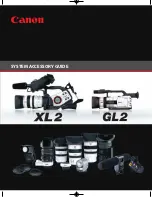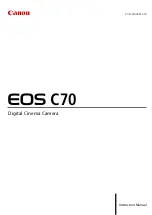
DCSG
U
SER
’
S
M
ANUAL
©
2007
V
IDERE
D
ESIGN
6
3.2 Color and Monochrome
The imager is either monochrome (DCSG) or color Bayer pattern (DCSG-
C). Output is 1 byte/pixel for either device. The Bayer pattern is converted
into color information on the host computer, via routines in the DCAM
software.
3.3 Frame
Rates
The IEEE 1394 interface on the DCSG supports a maximum rate of 400
Mbps from the imager. Frame rates up to 60 Hz at 640x480 are supported.
See Table 3-1 below for a complete list of frame rates.
3.4 50 Hz Option
Indoor lighting, especially from fluorescent fixtures, can oscillate at the
frequency of the electrical supply. If the image frame rate does not divide
evenly into this frequency, there can be moving horizontal bands of
alternating light and dark moving in the output.
For countries with 60 Hz power such as the United State, the standard
frame rates are ideal. In many other countries, the electrical line frequency
is 50 Hz. For these countries, there is a mode to change the frame rates of
the DCSG to sub-multiples of 50 Hz. These frame rates are shown in the
last column of Table 3-1
3.5 Multiple
Devices
Multiple DCSG devices can be attached to the same IEEE 1394 bus. When
streaming video at the same frame rate, they are synchronized, so that they
capture images at the same time.
Each IEEE 1394 PC Card or PCI Card defines a separate IEEE 1394 bus.
The two or three ports on the card all belong to the same bus, as does any
IEEE 1394 hub connected to these ports. Separate PC Cards and PCI Cards
cannot be connected to each other.
The number of devices that can simultaneously send video is determined by
the maximum bandwidth of the bus for isochronous transfers: 32 MB/s.
This rate cannot be exceeded by the combined video streams on the bus.
Table 2 shows the bandwidth requirements for the DCSG in various modes
and for various frame rates. Using this table, it is possible to determine the
maximum number devices that can stream video simultaneously. For
example, at 15 Hz and 640x480 resolution, a maximum of 6 DCSG devices
can send video information at the same time.
The bus bandwidth consumed by a device is more than would be expected
from just counting the number of bytes in each frame, because there are
blank cycles on the bus, when no data is being transmitted, even though the
bandwidth is reserved. Thus, it makes no difference whether the rate is 30
Hz or 25 Hz, the bus bandwidth consumed is the same.
.
Frame Size Frame rate,
standard
Frame rate,
50 Hz option
60 Hz
50 Hz
30 Hz
25 Hz
15 Hz
12.5 Hz
640x480
7.5 Hz
6.25 Hz
Table 3-1 Supported frame rates for the
DCSG, 400 Mbps IEEE 1394 bus.
Frame
size
Bus MB per
frame -
stereo
60 / 50
Hz
30 / 25
Hz
15 / 12.5
Hz
7.5 / 6.25
Hz
640x480
0.342 MB
20.5 MB
10.2 MB
5.12 MB
2.6 MB
Table 2 Bus bandwidth requirements at different frame rates.







































